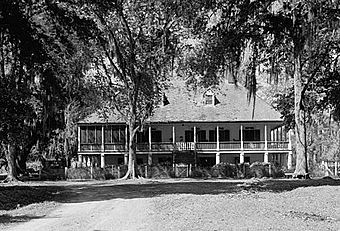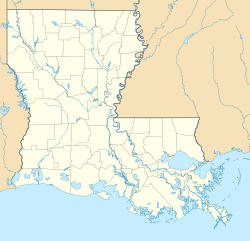Parlange Plantation House facts for kids
|
Parlange Plantation House
|
|

Parlange Plantation House, 1936 HABS photo
|
|
| Nearest city | Mix, Louisiana |
|---|---|
| Built | c. 1750 |
| Architectural style | French Colonial |
| NRHP reference No. | 70000258 |
Quick facts for kids Significant dates |
|
| Added to NRHP | April 15, 1970 |
| Designated NHL | May 30, 1974 |
The Parlange Plantation House is a very old and important house in Pointe Coupee Parish, Louisiana. It was built around 1750. This house is a great example of a large French Colonial plantation home in the United States.
A plantation house is a big home on a large farm, often where crops like sugar or cotton were grown. The Parlange Plantation House shows the style of homes built in the warm, river areas of Louisiana. It is a two-story "raised cottage." This means the main living floor is built on top of a brick basement. Brick pillars support the porch, called a veranda, on the second floor. The bricks for the basement were made right there on the plantation.
The walls, both inside and out, were covered with a special plaster. This plaster was made from a mix of mud, sand, Spanish moss, and animal hair. This old building method is called bousillage (boo-see-AHJ). After drying, the walls were painted. Both the ground floor and the second floor have seven rooms. These rooms are set up in two rows. The walls and ceilings throughout the house were made from strong, close-fitting planks of bald cypress wood.
Near the house, there is a unique octagonal building called a pigeonnier. This was a special house for pigeons. Pigeons were often raised for food and their droppings could be used as fertilizer. The home used to have a beautiful formal garden around it. Sadly, this garden was destroyed during the American Civil War.
Contents
The History of Parlange Plantation
Early Owners and Crops
The land for Parlange Plantation was first given to Vincent de Ternant by the French government. This was a "land grant," meaning he received the land officially. He developed about 10,000 acres (40 square kilometers) into a busy plantation. It was located along the False River.
At first, the main crop grown here was indigo. Indigo is a plant used to make a blue dye. When Vincent de Ternant's son, Claude, took over the plantation, he changed the main crops. He started growing sugarcane and cotton instead. These were very important "cash crops" at the time. A cash crop is grown to be sold for money, not just for the family to use.
The Parlange Family and the Civil War
After Claude de Ternant passed away, his second wife, Virginie, got married again. Her new husband was Colonel Charles Parlange, who was also French. The plantation then took his name, becoming Parlange Plantation.
During the American Civil War, the Parlange Plantation House was used by both sides. Sometimes, it was the headquarters for Union General Nathaniel P. Banks. Other times, it was the headquarters for Confederate General Richard Taylor. A headquarters is the main office or command center for an army leader.
Colonel and Mrs. Parlange had a son, also named Charles. He survived the Civil War and had a very important career. He became a State Senator in Louisiana, helping to make laws. He was also a United States Attorney, which means he worked for the government as a lawyer. Later, he served as Lieutenant Governor of Louisiana. This is the second-highest elected official in the state. He then became a federal judge and finally a justice on the Louisiana Supreme Court. A justice on the Supreme Court helps decide important legal cases for the state.
A Family's Legacy Today
Virginie Parlange died in 1887. Her son, Charles, and his wife then moved to New Orleans. For the next twenty years, Judge Charles Parlange and his wife rented out the plantation to other farmers.
Later, their son, Walter Parlange, returned to Pointe Coupée Parish. He decided to continue the family tradition and became a plantation farmer.
Today, Parlange Plantation still has about 1500 acres (6 square kilometers) of land. It is still used as a farm, raising cattle and growing sugarcane. The plantation is still owned and run by the descendants of the original owners. The main plantation house is mostly the same as it was long ago. Sometimes, you can arrange private tours to see it. The house is located near where Louisiana Highway 1 and Louisiana Highway 78 meet.



